Blue ocean strategy
This small post could easily decorate the most read blog " Learn to work ", but ...

... but I want to tell this story in relation to the competition from Intel - perhaps the described strategy will help to win the competition. Perhaps for some it will not be a discovery, but someone will adopt.
At one time, a team of authors from the well-known business school INSEAD released the book Blue Ocean Strategy ( Blue Ocean Strategy ), which outlined the key points of their proposed methodology.
')
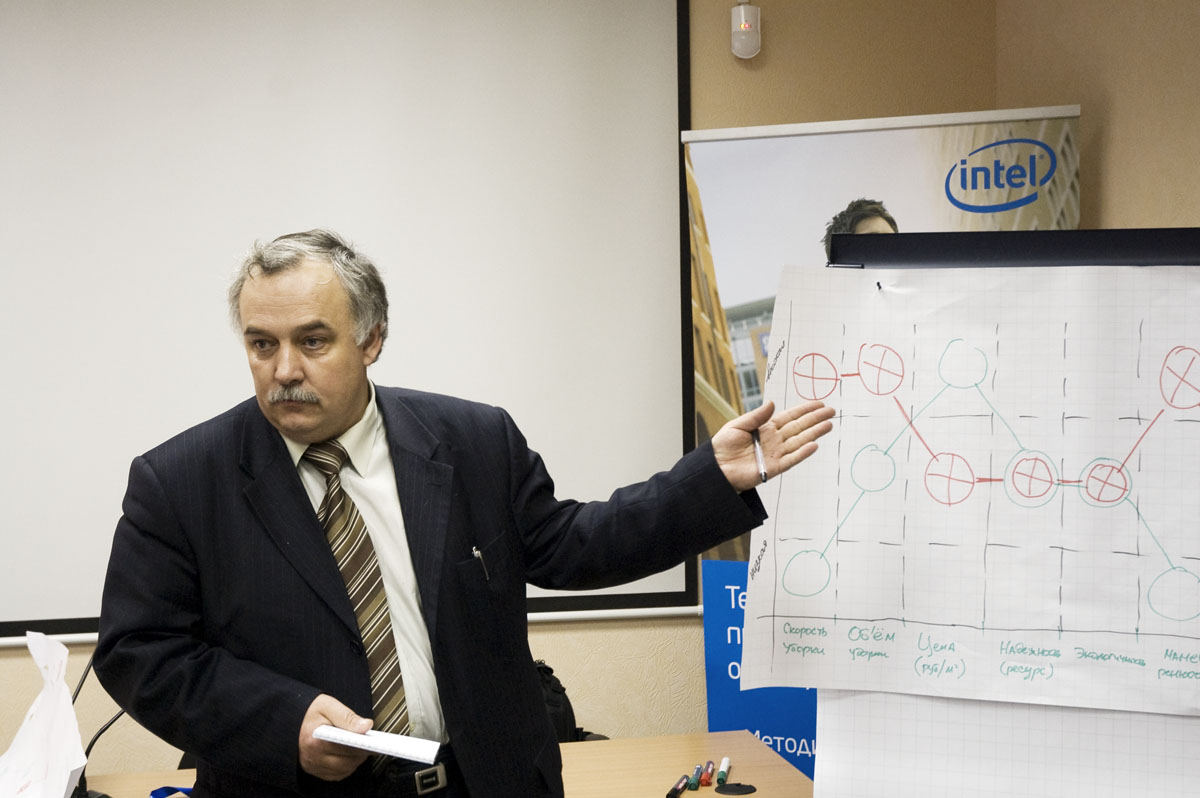
Without going into the depths of the ocean details: the authors of the book propose to present all existing markets in the form of two large oceans, in which entrepreneurs swim and earn money. Schematically:
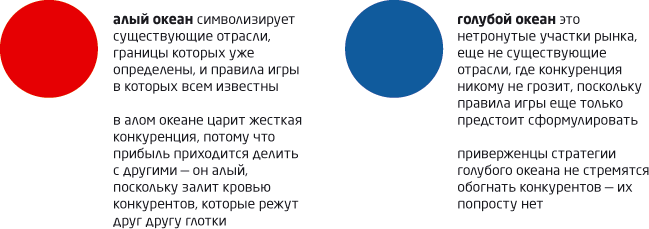
It is obvious that the overwhelming majority of entrepreneurs flounder precisely in the first reservoir - ruthless competition, the constant pursuit of profit does sometimes take on a scarlet color. The second ocean is much more calm - there is silence, grace and, in principle, the same money ... but how to get there?
To answer this question, a strategic canvas method was proposed, which can be clearly described by the following example.
Imagine - the 1940s, a small Scandinavian country. In the existing furniture market, a typical example of a scarlet ocean has developed - healthy competition, but on the whole the whole range is rather monotonous. Expensive furniture made of precious wood, beautifully presented assembled in the central city stores. The furniture is almost eternal, so even grandchildren will serve - choose, buy, pack everything and deliver.
If you disassemble everything into several parameters, you can present the activity in a disassembled form as follows:
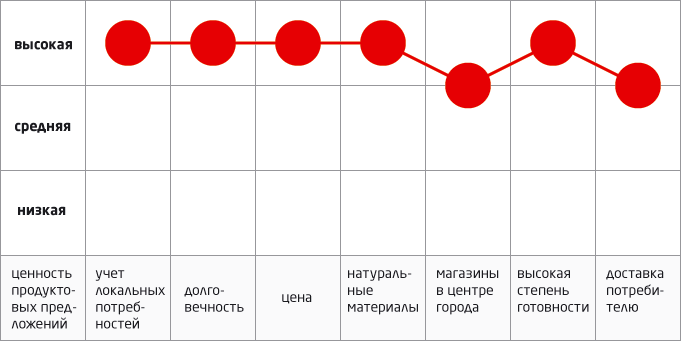
Since in this situation the competition was great, then, apparently, it suited the needs of local buyers. You could, of course, try your hand at eating a common cake, but then there are other options. If you put the "points" in the opposite direction, you get a separate market segment.
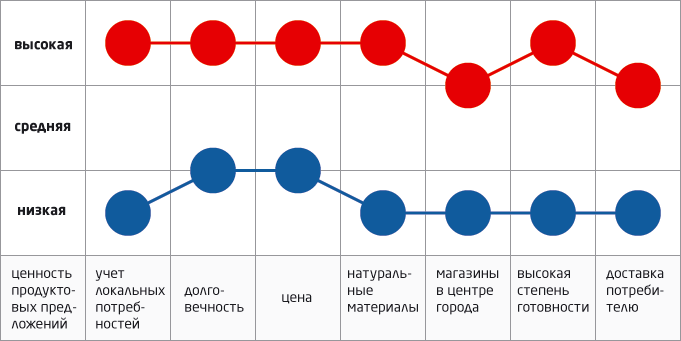
That's right - inexpensive and not very durable furniture made of doubtful materials, sold in stores on the outskirts of the city in a disassembled form and not delivered to the buyer (at least, not delivered free of charge). It would seem, who needs all this? However, the state of a person whom a bright thought once visited is at the moment about 23 billion dollars - this is Ingvar Kamprad and he is considered to be one of the richest people in the world. What is the name of his company, you probably already guessed. This is IKEA.
It is obvious that it is very easy to use this technique - it is enough to choose the existing market of the scarlet ocean, analyze its key parameters and build a graph using it, and then create an antiphase proposal. The success of the result is not guaranteed, but according to the ideas of the authors, the idea will be in the blue ocean and, most likely, will surprise you with its novelty. What is important, you can use it in many places.
You can practice without closing the post - here, for example, the key parameters of laptops, presented in the form of graphs. Try to come up with an “antinotebook” - I wonder what you do? You can share in the comments.
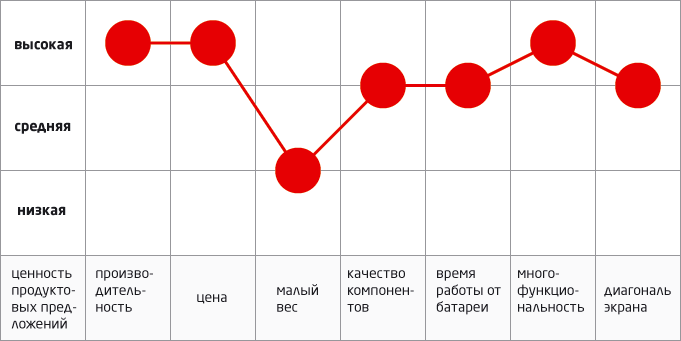
Taking this opportunity, I will hint - in the near future, this strategy can be applied in the " Useful Ideas " competition from Intel. Despite the genuine interest of the participants, the absence of “fresh thinking” is periodically traced - many try to swim in the scarlet ocean, thus reducing their own chances of winning. By the way, the good news is, by popular demand, we are extending the first stage of the competition - the reception of entries will last until April 15.
And for those who want to compete for more valuable prizes (aaa car dealership), I’m preying to try out a new tactic in the " Case for a Million " competition.

Try it - in a good way, there are 15 minutes to do. And, I hope, this strategy will help you more than once in the future. And yes - the post is based on Intel Galaxy materials.
Successes!

... but I want to tell this story in relation to the competition from Intel - perhaps the described strategy will help to win the competition. Perhaps for some it will not be a discovery, but someone will adopt.
At one time, a team of authors from the well-known business school INSEAD released the book Blue Ocean Strategy ( Blue Ocean Strategy ), which outlined the key points of their proposed methodology.
')

Without going into the depths of the ocean details: the authors of the book propose to present all existing markets in the form of two large oceans, in which entrepreneurs swim and earn money. Schematically:

It is obvious that the overwhelming majority of entrepreneurs flounder precisely in the first reservoir - ruthless competition, the constant pursuit of profit does sometimes take on a scarlet color. The second ocean is much more calm - there is silence, grace and, in principle, the same money ... but how to get there?
To answer this question, a strategic canvas method was proposed, which can be clearly described by the following example.
Imagine - the 1940s, a small Scandinavian country. In the existing furniture market, a typical example of a scarlet ocean has developed - healthy competition, but on the whole the whole range is rather monotonous. Expensive furniture made of precious wood, beautifully presented assembled in the central city stores. The furniture is almost eternal, so even grandchildren will serve - choose, buy, pack everything and deliver.
If you disassemble everything into several parameters, you can present the activity in a disassembled form as follows:

Since in this situation the competition was great, then, apparently, it suited the needs of local buyers. You could, of course, try your hand at eating a common cake, but then there are other options. If you put the "points" in the opposite direction, you get a separate market segment.

That's right - inexpensive and not very durable furniture made of doubtful materials, sold in stores on the outskirts of the city in a disassembled form and not delivered to the buyer (at least, not delivered free of charge). It would seem, who needs all this? However, the state of a person whom a bright thought once visited is at the moment about 23 billion dollars - this is Ingvar Kamprad and he is considered to be one of the richest people in the world. What is the name of his company, you probably already guessed. This is IKEA.
It is obvious that it is very easy to use this technique - it is enough to choose the existing market of the scarlet ocean, analyze its key parameters and build a graph using it, and then create an antiphase proposal. The success of the result is not guaranteed, but according to the ideas of the authors, the idea will be in the blue ocean and, most likely, will surprise you with its novelty. What is important, you can use it in many places.
You can practice without closing the post - here, for example, the key parameters of laptops, presented in the form of graphs. Try to come up with an “antinotebook” - I wonder what you do? You can share in the comments.

Taking this opportunity, I will hint - in the near future, this strategy can be applied in the " Useful Ideas " competition from Intel. Despite the genuine interest of the participants, the absence of “fresh thinking” is periodically traced - many try to swim in the scarlet ocean, thus reducing their own chances of winning. By the way, the good news is, by popular demand, we are extending the first stage of the competition - the reception of entries will last until April 15.
And for those who want to compete for more valuable prizes (aaa car dealership), I’m preying to try out a new tactic in the " Case for a Million " competition.

Try it - in a good way, there are 15 minutes to do. And, I hope, this strategy will help you more than once in the future. And yes - the post is based on Intel Galaxy materials.
Successes!
Source: https://habr.com/ru/post/89286/
All Articles